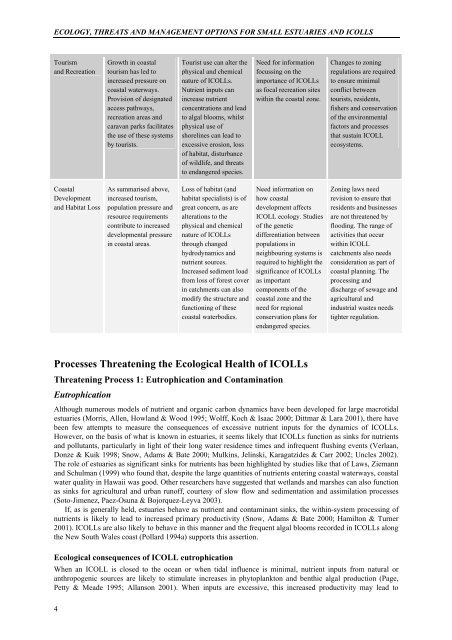icolls - Sustainable Tourism CRC
icolls - Sustainable Tourism CRC
icolls - Sustainable Tourism CRC
Create successful ePaper yourself
Turn your PDF publications into a flip-book with our unique Google optimized e-Paper software.
ECOLOGY, THREATS AND MANAGEMENT OPTIONS FOR SMALL ESTUARIES AND ICOLLS<br />
<strong>Tourism</strong><br />
and Recreation<br />
Coastal<br />
Development<br />
and Habitat Loss<br />
4<br />
Growth in coastal<br />
tourism has led to<br />
increased pressure on<br />
coastal waterways.<br />
Provision of designated<br />
access pathways,<br />
recreation areas and<br />
caravan parks facilitates<br />
the use of these systems<br />
by tourists.<br />
As summarised above,<br />
increased tourism,<br />
population pressure and<br />
resource requirements<br />
contribute to increased<br />
developmental pressure<br />
in coastal areas.<br />
Tourist use can alter the<br />
physical and chemical<br />
nature of ICOLLs.<br />
Nutrient inputs can<br />
increase nutrient<br />
concentrations and lead<br />
to algal blooms, whilst<br />
physical use of<br />
shorelines can lead to<br />
excessive erosion, loss<br />
of habitat, disturbance<br />
of wildlife, and threats<br />
to endangered species.<br />
Loss of habitat (and<br />
habitat specialists) is of<br />
great concern, as are<br />
alterations to the<br />
physical and chemical<br />
nature of ICOLLs<br />
through changed<br />
hydrodynamics and<br />
nutrient sources.<br />
Increased sediment load<br />
from loss of forest cover<br />
in catchments can also<br />
modify the structure and<br />
functioning of these<br />
coastal waterbodies.<br />
Need for information<br />
focussing on the<br />
importance of ICOLLs<br />
as focal recreation sites<br />
within the coastal zone.<br />
Need information on<br />
how coastal<br />
development affects<br />
ICOLL ecology. Studies<br />
of the genetic<br />
differentiation between<br />
populations in<br />
neighbouring systems is<br />
required to highlight the<br />
significance of ICOLLs<br />
as important<br />
components of the<br />
coastal zone and the<br />
need for regional<br />
conservation plans for<br />
endangered species.<br />
Processes Threatening the Ecological Health of ICOLLs<br />
Threatening Process 1: Eutrophication and Contamination<br />
Eutrophication<br />
Changes to zoning<br />
regulations are required<br />
to ensure minimal<br />
conflict between<br />
tourists, residents,<br />
fishers and conservation<br />
of the environmental<br />
factors and processes<br />
that sustain ICOLL<br />
ecosystems.<br />
Zoning laws need<br />
revision to ensure that<br />
residents and businesses<br />
are not threatened by<br />
flooding. The range of<br />
activities that occur<br />
within ICOLL<br />
catchments also needs<br />
consideration as part of<br />
coastal planning. The<br />
processing and<br />
discharge of sewage and<br />
agricultural and<br />
industrial wastes needs<br />
tighter regulation.<br />
Although numerous models of nutrient and organic carbon dynamics have been developed for large macrotidal<br />
estuaries (Morris, Allen, Howland & Wood 1995; Wolff, Koch & Isaac 2000; Dittmar & Lara 2001), there have<br />
been few attempts to measure the consequences of excessive nutrient inputs for the dynamics of ICOLLs.<br />
However, on the basis of what is known in estuaries, it seems likely that ICOLLs function as sinks for nutrients<br />
and pollutants, particularly in light of their long water residence times and infrequent flushing events (Verlaan,<br />
Donze & Kuik 1998; Snow, Adams & Bate 2000; Mulkins, Jelinski, Karagatzides & Carr 2002; Uncles 2002).<br />
The role of estuaries as significant sinks for nutrients has been highlighted by studies like that of Laws, Ziemann<br />
and Schulman (1999) who found that, despite the large quantities of nutrients entering coastal waterways, coastal<br />
water quality in Hawaii was good. Other researchers have suggested that wetlands and marshes can also function<br />
as sinks for agricultural and urban runoff, courtesy of slow flow and sedimentation and assimilation processes<br />
(Soto-Jimenez, Paez-Osuna & Bojorquez-Leyva 2003).<br />
If, as is generally held, estuaries behave as nutrient and contaminant sinks, the within-system processing of<br />
nutrients is likely to lead to increased primary productivity (Snow, Adams & Bate 2000; Hamilton & Turner<br />
2001). ICOLLs are also likely to behave in this manner and the frequent algal blooms recorded in ICOLLs along<br />
the New South Wales coast (Pollard 1994a) supports this assertion.<br />
Ecological consequences of ICOLL eutrophication<br />
When an ICOLL is closed to the ocean or when tidal influence is minimal, nutrient inputs from natural or<br />
anthropogenic sources are likely to stimulate increases in phytoplankton and benthic algal production (Page,<br />
Petty & Meade 1995; Allanson 2001). When inputs are excessive, this increased productivity may lead to











